
views
Finding a Good Spot

Find a flat area. The best areas for building a tarp shelter are places that have flat ground. This can make creating the shelter a bit easier and will allow you a more comfortable place to sleep in. Take some time to find a nice, flat area before building your tarp shelter.
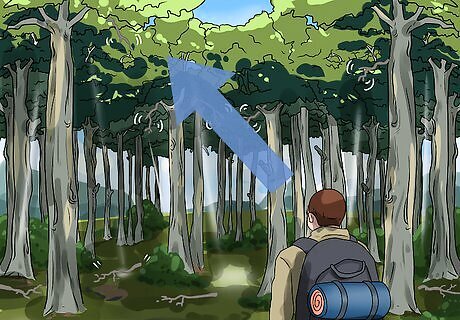
Look above for dead branches. Once you've found a nice place on the ground for your shelter, you will want to look above it. Dead branches can pose a serious hazard to campers if they are knocked down by wind. Always avoid placing your shelter under any branches that look old, dead, or dangerous to avoid having one fall on you.

Look for trees you can use. Many tarp shelter designs require you to place a sturdy cord or rope between two trees. This cord will act as the ridge-line for your tarp shelter. It's a good idea to look for a flat spot that has two trees for you to place this cord between. If you can't find two trees, you could try placing two anchor branches in the ground instead. These trees should be roughly as far apart as your tarp is long.
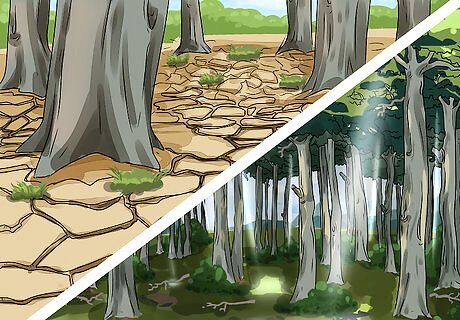
Consider the weather. Although it may be sunny and dry when you set your tarp shelter up, the weather may change during your camping trip. It's important to consider what the weather might do in the near future, allowing you to stay comfortable and avoid any damage to your tarp shelter. Figure out which way the winds are blowing. Any “wall” of your tarp shelter should face away from the wind. Avoid putting your shelter in any areas that are low or seem like they could flood during rain storms.
Making an A-Frame Shelter
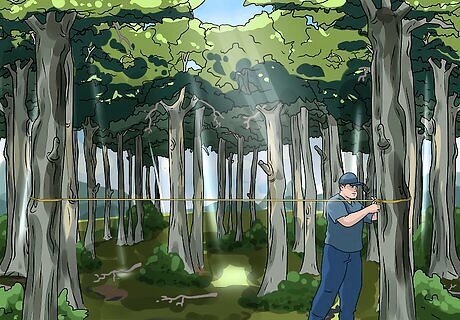
Create the ridge-line. The ridge-line will support the top section of your tarp shelter. This line is created by stringing a length of cord between two trees. This gives your tarp an elevated point of support and will form the shape of the a-frame tarp shelter. Place the ridge-line using these steps: Tie one section of the rope to a tree. Place it as high up the tree trunk as you would like the roof of your tarp shelter to be. Bring the other end over to the adjacent tree and tie it at the same level. Make sure the cord is as tight as it can be to ensure a strong ridge-line.
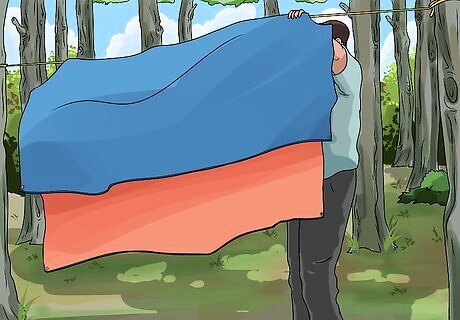
Lay the tarp over the rope. Once your ridge-line has been created, you can lay the tarp over top of it. For an a-frame tarp shelter, place the tarp over the ridge-line in the center of the tarp. This will leave equal halves of the tarp hanging down from the ridge-line. Make sure the tarp is equally hanging from both sides of the ridge-line to avoid problems.
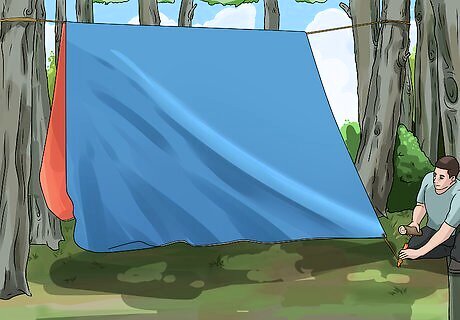
Anchor the tarp to the ground. After you've placed the tarp over the ridge-line, you can fasten it to the ground. Take one of the bottom sections of tarp and pull it outwards, away from the center of the tent. Once you've gotten it to a place that you like, secure it to the ground by taking these steps: Place a tent stake into the ground, near to the point the tarps corner while it is stretched out. Tie a length of cord between the tent stake and the corner of the tarp. Make sure this cord is tight and holds the tarp securely to the ground. Do the same thing for each of the other three corners of your a-frame tarp shelter.
Making a Lean-to Shelter
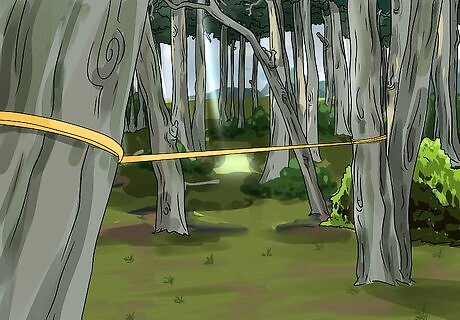
Find a good spot for the cord. The lean-to tarp shelter makes use of a ridge-line. This ridge-line is created by tying a length of rope tightly between two trees or other points of support. This will create a point that you can secure your tarp to and finish your shelter. Find two trees that are as far apart as your tarp is long. Tie one end of the rope around the trunk of a tree. Tie it at the height that you want the top of your shelter to be at. Tie the other end of the rope at the same level on the opposite tree. It's very important that the ridge-line is as tight as it can be.

Fix one edge of the tarp to the cord. The lean-to tarp shelter requires you to fix one edge of your tarp to your ridge-line. You can attach the tarp to the ridge-line using cord or rope and many tarps will come with grommets or loops built in. Make sure you attach the tarp to the ridge-line tightly to build a strong tarp shelter. Your tarp may have holes pre-made along its edge. If so, you can thread the ridge-line through these for an easy way to join them together. Many tarps will have loops along the corners or edges that can be used to tie them to your ridge-line.

Anchor the tarp to the ground. Once the top edge has been tied to the ridge-line, you can secure the bottom edge of the lean-to tarp shelter. Pull the bottom edge away from the center until it is at an angle that you want. Place anchoring stakes in the ground at the corners of the tarp and tie the tarp to them. This will hold the bottom portion of your shelter securely in place. Most people recommend using a 45 degree angle for their lean-to. Try adjusting the angle to raise or lower the height of the shelter's "ceiling".




















Comments
0 comment